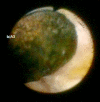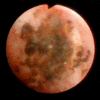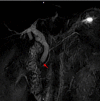Diagnostic value of magnetic resonance cholangiopancreatography for secondary common bile duct stones compared with laparoscopic trans-cystic common bile duct exploration
- PMID: 24894946
- PMCID: PMC4061148
- DOI: 10.12659/MSM.890831
Diagnostic value of magnetic resonance cholangiopancreatography for secondary common bile duct stones compared with laparoscopic trans-cystic common bile duct exploration
Abstract
Background: The aim of this study was to evaluate the diagnostic potential of magnetic resonance cholangiopancreatography (MRCP) in preoperative patients with secondary common bile duct stones during the application of laparoscopic trans-cystic common bile duct exploration (LTCBDE).
Material and methods: The clinical records of 255 patients were retrospectively analyzed. All patients included in the study were examined by MRCP 3 days prior to LTCBDE.
Results: Secondary bile duct stones were detected in 220 patients using LTCBDE. Of the patients diagnosed by MRCP, 141 were true-positive, 28 were true-negative, 7 were false-positive and 79 were false-negative. The sensitivity, specificity, accuracy, positive predictive value, and negative predictive value of MRCP for secondary common bile duct stones were 64.09%, 80.00%, 66.27%, 95.27%, and 26.17%, respectively. When the cases with muddy stones were excluded, the outcomes were 80.41%, 79.41%, 69.23%, 94.44%, and 48.21%, respectively. When cases with stones <3 mm (inclusive) in diameter were excluded, the outcomes were 93.75%, 79.41%, 86.27%, 93.75%, and 65.85%, respectively. When cases with stones <5 mm (inclusive) in diameter were excluded, the outcomes were 93.10%, 79.41%, 89.26%, 92.05%, and 81.82%, respectively.
Conclusions: The effectiveness of preoperative MRCP is overestimated for the diagnosis of secondary common bile duct stones, particularly for muddy and micro-stones.
Figures
Similar articles
-
Diagnostic performance of laparoscopic transcystic common bile duct exploration for the detection of choledocholithiasis in patients with negative MRCP.Updates Surg. 2023 Oct;75(7):1887-1891. doi: 10.1007/s13304-023-01524-5. Epub 2023 May 19. Updates Surg. 2023. PMID: 37204658
-
Preoperative routine magnetic resonance cholangiopancreatography before laparoscopic cholecystectomy: a prospective study.Eur J Surg. 2002;168(12):690-4. doi: 10.1080/11024150201680024. Eur J Surg. 2002. PMID: 15362577
-
Elective laparoscopic cholecystectomy without intraoperative cholangiography: role of preoperative magnetic resonance cholangiopancreatography - a retrospective cohort study.BMC Surg. 2016 Jul 13;16(1):45. doi: 10.1186/s12893-016-0159-9. BMC Surg. 2016. PMID: 27411676 Free PMC article.
-
Single-stage laparoscopic common bile duct exploration and cholecystectomy versus two-stage endoscopic stone extraction followed by laparoscopic cholecystectomy for patients with gallbladder stones with common bile duct stones: systematic review and meta-analysis of randomized trials with trial sequential analysis.Surg Endosc. 2018 Sep;32(9):3763-3776. doi: 10.1007/s00464-018-6170-8. Epub 2018 Mar 30. Surg Endosc. 2018. PMID: 29603004
-
Laparoscopic common bile duct exploration plus cholecystectomy versus endoscopic retrograde cholangiopancreatography plus laparoscopic cholecystectomy for cholecystocholedocholithiasis: a meta-analysis.Surg Endosc. 2019 Oct;33(10):3275-3286. doi: 10.1007/s00464-018-06613-w. Epub 2018 Dec 3. Surg Endosc. 2019. PMID: 30511313 Review.
Cited by
-
Routine Cysticotomy and Flushing of the Cystic Duct in Patients with Low Risk of Common Duct Stones: Can It Be Beneficial?Minim Invasive Surg. 2017;2017:9814389. doi: 10.1155/2017/9814389. Epub 2017 Jul 11. Minim Invasive Surg. 2017. PMID: 28781893 Free PMC article.
-
Safe laparoscopic clearance of the common bile duct in emergently admitted patients with choledocholithiasis and cholangitis.Korean J Hepatobiliary Pancreat Surg. 2016 May;20(2):53-60. doi: 10.14701/kjhbps.2016.20.2.53. Epub 2016 May 11. Korean J Hepatobiliary Pancreat Surg. 2016. PMID: 27212991 Free PMC article.
-
Optimal Evaluation of Suspected Choledocholithiasis: Does This Patient Really Have Choledocholithiasis?Clin Endosc. 2017 Sep;50(5):415-416. doi: 10.5946/ce.2017.146. Epub 2017 Sep 29. Clin Endosc. 2017. PMID: 29017296 Free PMC article. No abstract available.
-
The Diagnostic Value of GGT-Based Biochemical Indicators for Choledocholithiasis with Negative Imaging Results of Magnetic Resonance Cholangiopancreatography.Contrast Media Mol Imaging. 2022 Jun 27;2022:7737610. doi: 10.1155/2022/7737610. eCollection 2022. Contrast Media Mol Imaging. 2022. PMID: 35949700 Free PMC article.
-
Accuracy of magnetic resonance cholangiography compared to operative endoscopy in detecting biliary stones, a single center experience and review of literature.World J Radiol. 2015 Apr 28;7(4):70-8. doi: 10.4329/wjr.v7.i4.70. World J Radiol. 2015. PMID: 25918584 Free PMC article.
References
-
- Bilzhartz LE, Horton JD. Gallstone disease and its complications. In: Feldeman M, Scharschmidt BF, Sleizenger MH, editors. Sleizenger and Fordtran’s Gastrointestinal and Liver Disease: Pathophysiology, Diagnosis, Management. Philadelphia: WB Sauders Company; 1998. pp. 948–72.
-
- Ellison EC. One-stage treatment for CBDS discovered during laparoscopic cholecystectomy is not practical: Comment on “Treatment for retrieved common bile duct stones during laparoscopic cholecystectomy”. Arch Surg. 2010;145(12):1145–49. - PubMed
-
- Azary SY, Kalbasi H, Setayesh A, et al. Predictive value and main determinants of abnormal features of intraoperative cholangiography during cholecystectomy. Hepatobiliary Pancreat Dis Int. 2011;10(3):308–12. - PubMed
-
- Bret PM, Reinhold C. Magnetic resonance cholangiopancreatography. Endoscopy. 1997;29(6):472–86. - PubMed
-
- Stiris MG, Tennøe B, Aadland E, Lunde OC. MR cholangiopancreaticography and endoscopic retrograde cholangiopancreaticography in patients with suspected common bile duct stones. Acta Radiol. 2000;41(3):269–72. - PubMed
Publication types
MeSH terms
LinkOut - more resources
Full Text Sources
Other Literature Sources






